St. Helena’s Stained Glass Windows
HISTORY
It all began during the winter of 2015 at a Parish Council meeting, when the matter of replacing the plain white curtain that screened the tabernacle was discussed. Several suggestions were made including a single stained glass window (See "St. Helena Parish Council Minutes from November 18, 2015"). A parishioner attending the meeting as an observer took it upon himself, to determine what might be done with respect to a stained glass window. Contact was made and information received from two sources. At a later meeting this parishioner advised the Council of his efforts and offered to be responsible for all costs in providing the window. This led to an extended discussion of what the makeup of the window might be and Fr. Pedro Poloche, as pastor, expressed his desire to have the Seven Sacraments of the Catholic faith represented in the window. Though obviously most appropriate, there was concern that the depictions would be minimal if confined to the one window panel. The parishioner then suggested that in view of there being seven windows in the church, perhaps it would be best to have each Sacrament separately depicted in each window. The Council agreed to the suggestion and it was determined that a survey was conducted to determine if the congregation agreed with the installation. A majority of the Parish agreed to have stained glass windows installed, and it was determined that Fr. Pedro would determine how the Sacraments were to be depicted.
The stained glass windows were installed during the first days of May 2017, and blessed and dedicated on Sunday, May 7th 2017.
COLORS AND SHAPES:
PERIDOT: is the predominant color, in reference to St. Helena, the Parish patroness whose feast day is celebrated on August 18th.
RUBY: is seen at the center in reference to the most Holy Sacrifice of our Lord and Savior.
AMBER: is found on the edges. The amber color is intended as a reminder of the sacredness of this place, and of our personal and universal call to holiness.
SAPPHIRE: represents God’s wisdom and faithfulness to His promises. It was used as an implicit reference to the mother and daughter whose memories are being honored through this donation.
The sacrament’s depictions are placed in an ascending trend toward the center, where a depiction of the Most Holy Eucharist is located, because the Eucharist is "the source and summit of the Christian life" (Second Vatican Council, Dogmatic Constitution Lumen Gentium, No. 11), and "the other sacraments, and indeed all ecclesiastical ministries and works of the apostolate, are bound up with the Eucharist and are oriented toward it. For in the blessed Eucharist is contained the whole spiritual good of the Church, namely Christ himself" (Second Vatican Council, Decree on the Ministry and Life of Priests – Presbyterorum Ordinis, No. 5).
THE SEVEN SACRAMENTS
BAPTISM
Is the sacrament of regeneration through water and the Holy Spirit (John 3:5). The scallop shell is the symbol of Baptism and water is the proper matter for the conferring of the sacrament. Baptism is also the basis of the whole Christian life, the gateway to life in the Spirit, and the door which gives access to the other sacraments— that is the meaning of the seven drops. Through Baptism we are freed from sin, reborn as children of God, incorporated into His Church, consecrated to build His kingdom and empowered with His grace.
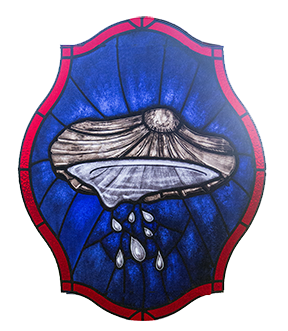
CONFIRMATION
Is the bestowal of Pentecost into every baptized Christian. The dove is the symbol of the Holy Spirit (Cf. Matthew 3:16; Mark 1:10; Luke 3:22; John 1:32). The seven flames represent his gifts of Wisdom, Understanding, Counsel, Fortitude, Knowledge, Piety and Fear of the Lord (Cf. Isaiah 11:2-3).
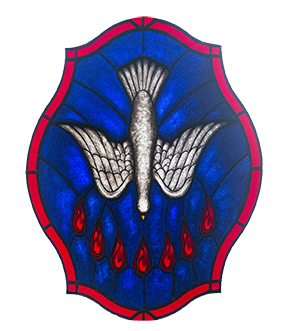
PENANCE
Consecrates the sinner's personal and ecclesial steps of conversion, repentance, and satisfaction and is represented by two crisscrossed keys and a hand. The keys are the symbol of the Church’s power to “bind and loose” (See Matthew 16:19; Isaiah 22:22, Revelation 3:7); and the hand represents the authority to forgive sins, which Jesus gave to the apostles and their successors (Cf. John 20:23).
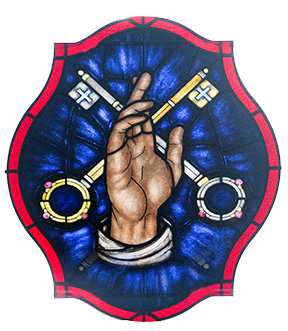
EUCHARIST
Is the sacrifice of our Savior’s body and blood, which He instituted at the Last Supper. It is the culmination of God's action sanctifying the world in Christ and of the worship mankind offer to Christ and through him to the Father in the Holy Spirit. A chalice and a host are surrounded by grapes and wheat shafts to represent the sacrifice of Him, who not only gave up his life as a ransom for us, but decided to remain as true food and drink for the Christian (Cf. John 6:55-56).
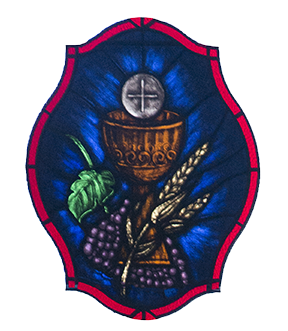
HOLY ORDERS
Is the sacrament through which the mission entrusted by Christ to his apostles continues to be exercised in the Church: thus it is the sacrament of apostolic ministry (Cf.Mathew 28:18) . The stole, which is a type of sash, and the open Bible are reminders of the priest’s authority and dignity as well as of his duty to preach the Word of God with courage and conviction.
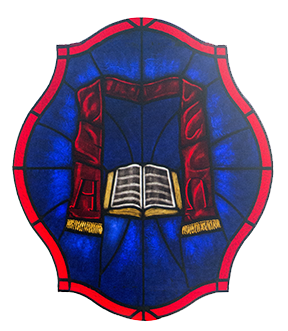
ANOINTING OF THE SICK
The disciples acquire a new outlook on illness and the sick by following Christ; who instructs them to share in his ministry of compassion and healing: "So they went out and preached that men should repent. And they cast out many demons, and anointed with oil many that were sick and healed them" (Mark 6:12-13). The Church believes and confesses that among the seven sacraments there is one especially intended to strengthen those who are being tried by illness; and it is called the Anointing of the Sick, which is represented by the oil container and the olive branch.
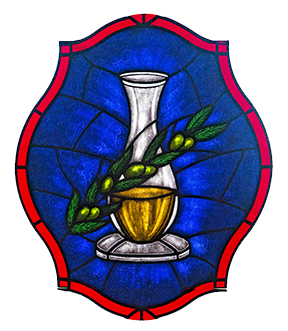
MATRIMONY
Is the covenant, by which a man and a woman establish between themselves a partnership of the whole of life. Holy Scripture affirms that man and woman were created for one another: "It is not good that the man should be alone" (Genesis 2:18). "Therefore a man leaves his father and his mother and cleaves to his wife, and they become one flesh" (Genesis 2:24). By its nature is ordered toward the good of the spouses and the procreation and education of offspring. This covenant between baptized persons has been raised by Christ the Lord to the dignity of a sacrament. Wedding rings symbolizes love and fidelity; the ring’s roundness represents the everlasting love the couple are called to have for each other.
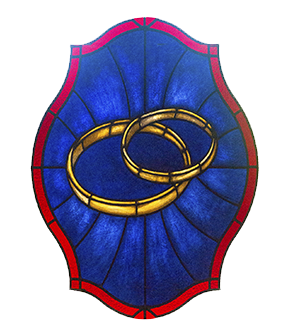

Interesting facts:
The seven Sacraments of the Church are organized in three groups: sacraments of initiation (Baptism, Confirmation and Eucharist); sacraments of healing (Penance and Anointing) and sacraments of service (Holy Orders and Matrimony). Following the above mentioned grouping, the proper order of the sacraments on the windows, should have been: Baptism, Confirmation, Penance, Eucharist, Anointing of the Sick, Holy Orders and Matrimony. But, since the installation of the stained glass windows was a bit of a stressful event in the life of the parish; father Pedro, decided to alter this “perfect” order, as a reminder that although the Church is called to be perfect (SeeMatthew 5:48), we still are to deal with the imperfections and disagreements of our human condition.
